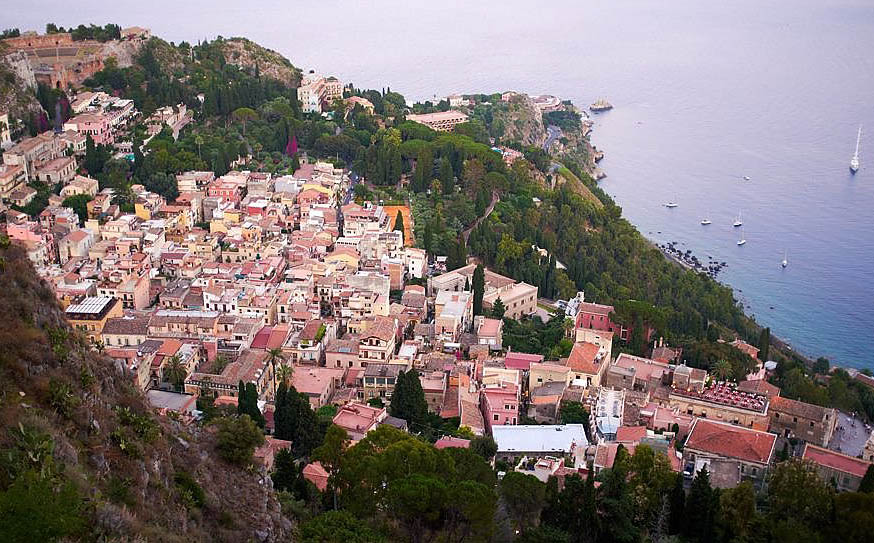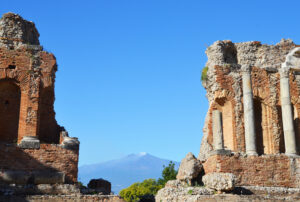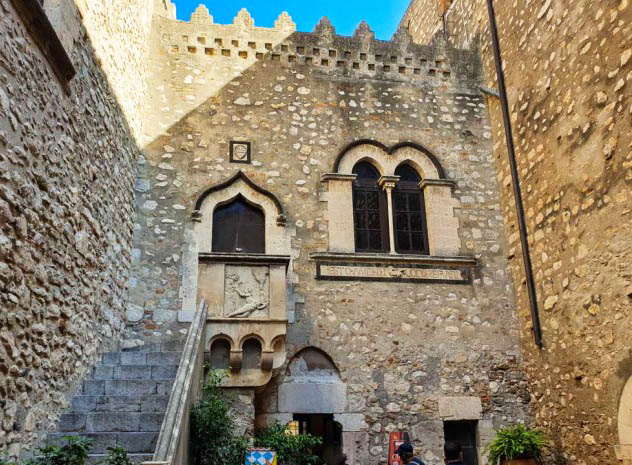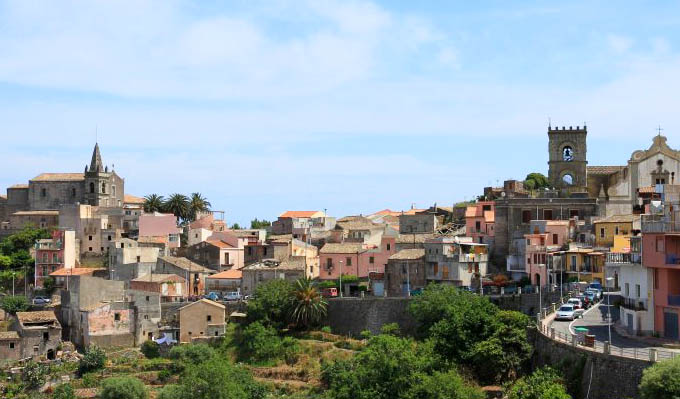
Did you know Taormina, Sicily, was one of the most popular towns to visit in Italy way back in the 18th century? Famous writers and intellects like D.H Lawrence, Oscar Wilde, and Truman Capote resided here while working on several of their masterpieces. Like many Italian towns, the history of Taormina is drenched in conflict and conquest. It thrived under Greek rule and prospered under the Roman Empire. As Rome collapsed Taormina like many cities under Roman rule began to crumble as well. Many centuries later in 1087 Taormina was seized by the Normans. However, their reign brought new life into the mostly abandoned town and slowly transformed it into a must-visit destination.
The Pearl of the Ionian Sea
Nicknamed the ‘pearl of the Ionian Sea’, this scenic town is perched on a rocky peninsula, surrounded by crystalline blue waters. Breathtaking views await you upon your arrival as you venture through the quaint historic stone streets dotted with vibrant shops and restaurants. The restored medieval buildings, churches, and Grecian amphitheater whisper tales of Taormina’s dramatic ancient past. As you explore this lively tourist destination you’ll feel a relaxing sense of belonging that makes people return to Taormina time and time again.
Greeks and Romans Fought for a Slice of Heaven

Historians confirm that Taormina was founded by Greeks around the same time they discovered Naxos (circa.734BC). When the Romans won the First Punic War (212 BC), they took over Taormina. The noble class enjoyed Taormina as an ideal spot for a restful retreat. Hence, its long history as a paradise-like resort town had begun. Taormina was often fought over by the Greeks and Romans because of much more than a beautiful place for a relaxing retreat. Strategically, the village offers a bird’s eye view of the sea from its mountain top location. Militarily, this offered a perfect vantage point to learn about attacks from the sea heading their way in advance.
The Middle Ages—Enter the Arabs
The fall of Rome led the Byzantine emperors to take over, followed by a 30-week siege that eventually declared Arabs as the rulers of Southern Italy (in 962 AD). Taormina was renamed “Al-Mu’izziyya” as a tribute to Imam-Caliph Al Mu‘izz the founder of Ciro, Egypt. All the while, Taormina transitioned into a meeting place for Arab mathematicians, pharmacists, and scientists. They also introduced agriculture and agrarian practices to the region such as citrus trees, honey, and mulberry to name a few. Furthermore, they also introduced new irrigation systems and more efficient ways of tilling the soil. As a result, Taormina and the surrounding areas flourished in a whole new way.
They Came, They Saw, They Conquered
The Normans overthrew the Arabs in 1079 and ushered in a big era of changes within the region. Charles of Anjou (1266-1286) took control with great support from Pope Urban IV and later was followed by the Swabian reign (1198 to 1266) led by Frederick II. Consequently, his arrival instigated a rebellion of where Sicilian towns collaborated to end the French Rule. However, a few centuries later, the Spaniards came into the picture. They took control and turned Palazzo Corvaja (the medieval palace of Taormina) into the seat of the Sicilian Parliament. This political move redirected attention to Taormina. Thereby, it kick-started the restoration of its many diverse historical sites, stunning natural landscape, and Greek/Roman remains.
What Makes Taormina the Best Place to Visit in Italy?

Taormina attracts travelers with archeological interests, artistic sensibilities, history buffs, trendsetting shoppers, gastronomy conasaurs, and beachgoers. Yes, there are beautiful beaches just a short distance from town. People come in troves for business, or pleasure to relish in the glamour and glitz of this world-renowned town.
One of the main attractions is Palazzo Corvaja, which is dubbed the ‘greatest symbol’ of history in Taormina. Its architectural design features an intermix of Arab, Norman, and Gothic styles. These include stoic battlements, a tower, mullioned windows, and well-shaded impeccable courtyards. Its original tower was built by the Arabs and influenced by sacred places of religion. The Normans expanded upon this design by adding a new wing to the tower to exhibit their artwork. Spanish conquers built another wing to make it fit for the Sicilian Parliament. Other significant sights to see and stories to learn while visiting Taormina are Porta Messina, Porta Catania, and the ancient Greek Theater
What to expect on your visit?

Enjoy Taormina as you immerse yourself into her magnificent ancient past. Its streets are well preserved and capture its authentic medieval infrastructure. The Greek-Roman amphitheater continues to intrigue crowds time and time again. And, let’s not forget the breathtaking beaches too! Taormina’s Mediterranean ambiance is a well-fitted blend of old, sacred, and new. There is literally something for everyone in this elegant Sicilian coastal town.
In a Nutshell
From a distance, Taormina may look like many quaint Italian towns. But, looks can be deceiving as we all know. Once you enter this pearl of a town you will begin to understand why the rich, famous and everyday tourists love it so very much. At Tavola Tours we specialize in Sicily and Taormina is one of our favorite towns to enjoy with our guests.


